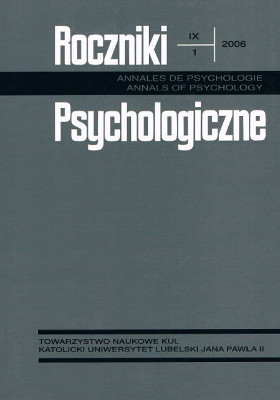Supersition and its measurement: Development of the Questionnaire of Belief Openness
Abstract
Superstition and an attempt to measure it: Questionnaire of Belief Openness. The first part of the article presents contemporary research on superstition, discusses its sources, universal vs local character, and belief in good luck and bad luck as the key elements of superstition. The second part of the paper presents development of the Questionnaire of Belief Openness (Kwestionariusz Otwartości Przekonań – KOP20) and research on its psychometric characteristics. It was found that KOP20 is practically uni-factorial scale of high homogeneity and almost perfect internal consistency (Cronbach’s a = 0.96). According to our predictions, test scores correlate negatively with level of education, and positively – with authoritarianism, anxiety, emotional reactivity and perseveration.
References
Altemeyer, B., Hunsberger, B. (1992). Authoritarianism, religious fundamentalism, quest and prejudice. The International Journal for the Psychology of Religion, 2, 113-133.
Auton, H. R., Pope, J., Seeger, G. (2003). It isn’t that strange: Paranormal belief and personality traits. Social Behavior and Personality, 31, 7, 711-720.
Brzozowski, P. (1997). Skala Dyrektywności Johna J. Raya. Warszawa: PTP.
Budner, S. (1962). Intolerance of ambiguity as a personality variable. Journal of Personality, 30, 29-50.
Ciborowski, T. (1997). “Superstition” in the collegiate baseball player. The Sport Psychologist, 11, 305-317.
Encyklopedia Powszechna (1985). Warszawa: PWN.
Evans, D. W., Milanak, M. E., Medeiros, B., Ross, J. L. (2002). Magical beliefs and rituals in young children. Child Psychiatry and Human Development, 33, 43-58.
Frenkel-Brunswick, E. (1949). Intolerance of ambiguity as a emotional and perceptual variable. Journal of Personality, 18, 108-143.
Freud, S. (1901/1997). Psychopatologia życia codziennego. Marzenia senne. Warszawa: PWN.
Grimmer, M. R., White, K. D. (1992). Nonconventional beliefs among Australian science and non-science students. The Journal of Psychology, 126, 5, 521-528.
Hock, R. R. (2003). 40 prac badawczych, które zmieniły oblicze psychologii. Sopot: Gdańskie Wydawnictwo Psychologiczne.
Jahoda, G. (1970). The psychology of superstition. Middlesex: Penguin Books, Ltd.
Katayama, H. (2004). Things Japanese: The world of Japanese superstition. Uzyskane 4 marca 2004 ze strony: http://mothra.rerf.or.jp/ENG/Hiroshima/Things/68.html
Kobyliński, S. (1990). Odpukajmy! Katowice: Krajowa Agencja Wydawnicza.
Korzeniowski, K. (2002). Autorytaryzm i jego psychologiczne konsekwencje. W: K. Skarzyńska (red.), Podstawy psychologii politycznej (s. 59-81). Poznań: Zysk i S-ka.
Mikołajczyk, M. (2000). Nie przechodź pod rozkraką. Charaktery, 36, 24-25.
Ninness, H. A. Ch., Ninness, S. K. (1999). Contingencies of superstition: Self-generated rules and responding during second-order response-independent schedules. The Psychological Record, 49, 221-243.
Opie, I., Tatem, M. (1990). A dictionary of superstitions. Oxford: Oxford University Press.
Pedhazur, E. J. (19822). Multiple regression in behavioral research. New York: Holt, Rinehart and Winston.
Peterson, C. (1978). Locus of control and belief in self-oriented superstitions. The Journal of Social Psychology, 105, 305-306
Prusik, M. (2001). Syndromatyczność postaw społeczno-politycznych społeczeństwa polskiego (nieopublikowana praca magisterska, Wydział Psychologii UW, Warszawa).
Radford, E., Radford, M. A. (1949/1969). Encyclopedia of superstitions. New York: Greenwood Press Publishers.
Randall, T. M., Desrosiers, M. (1980). Measurement of supernatural belief: Sex differences and locus of control. Journal of Personality Assessment, 44, 493-498.
Ray, J. J. (1980). Belief in luck and locus of control. The Journal of Social Psychology, 111, 299-300.
Ray, J. J. (1985). Defective validity in the Altemeyer Authoritarian Scale. The Journal of Social Psychology, 125, 2, 271-272.
Ray, J. J., Lovejoy, F. H. (1983). The behavioral validity of some recent measures of authoritarianism. The Journal of Social Psychology, 120, 91-99.
Rudski, J. (2003). What does a “superstitious” person believe? Impressions of participants. The Journal of General Psychology, 130, 4, 431-445.
Rudski, J. M., Lischner, M. I., Albert, L. M. (1999). Superstitious rule generation is affected by probability and type of outcome. The Psychological Record, 49, 245-260.
Skinner, B. F. (1948). ‘Superstition’ in the pigeon. Journal of Experimental Psychology, 38, 168-172.
Sosnowski, T. (2004). Zastosowanie analizy wielokrotnej regresji liniowej do analizy danych eksperymentalnych. Psychologia–Etologia–Genetyka, 9, 53-80.
Spielberger, C. D., Gorsuch, R. L., Lushene, R. E. (1970). Manual for the State-Trait Anxiety Inventory. Palo Alto, CA: Consulting Psychologists Press.
Strelau, J. (1998). Psychologia temperamentu. Warszawa: Wydawnictwo Naukowe PWN.
Strelau, J. (2000). Temperament. W: J. Strelau (red.), Psychologia: podręcznik akademicki (s. 683-719). Gdańsk: Gdańskie Wydawnictwo Psychologiczne.
Teigen, K. H., Evensen, P. C., Samoilow, D. K., Vatne, K. B. (1999). Good luck and bad luck: How to tell the difference. European Journal of Social Psychology, 29, 981-1010.
Thompson, C. J. S. (1932/1989). The hand of destiny: Folk-lore and superstition of everyday life. New York: Bell Publishing Company.
TNS OBOP (1994). Czy Polacy są przesądni? Raport, Warszawa.
TNS OBOP (1999). Powszechność przesądów w naszym społeczeństwie. Raport, Warszawa.
TNS OBOP (2003). Czy Polacy są przesądni? Raport, Warszawa.
Vyse, S. A. (1991). Behavioral variability and rule generation: General, restricted, and superstitious contingency statements. The Psychological Record, 41, 487-506.
Wiech, M. (2002). Kwestionariusz Epsilon-25 (mps pracy zaliczeniowej, Wydział Psychologii UW, Warszawa).
Wrześniewski, K., Sosnowski, T., Matusik, D. (2002). Inwentarz stanu i cechy lęku STAI. Polska adaptacja STAI. Podręcznik (wyd. II, rozszerzone). Warszawa: PTP.
Zawadzki, B., Strelau, J. (1997). Formalna charakterystyka zachowania – kwestionariusz temperamentu (FCZ-KT). Podręcznik. Warszawa: PTP.
Zimbardo, P. G., Ruch, F. L. (1997). Psychologia i życie. Warszawa: PWN.
Copyright (c) 2006 Roczniki Psychologiczne

This work is licensed under a Creative Commons Attribution-NonCommercial-NoDerivatives 4.0 International License.


